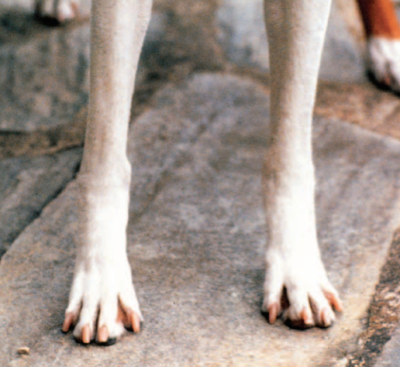
The Irish Water Spaniel’s breed standard indicates that the feet should be “large, round, somewhat spreading,” and standard for the English Bulldog calls for well-split toes, but neither are these the same thing as “splayed feet” in which the toes are spread quite apart. The opposite of tightly knit toes, splayed feet are also known as “open toed” or open-feet,” and in most breeds, it’s considered a fault, if not something to be strictly penalized.
Why is a splayed foot a problem? Because it’s inefficient. It doesn’t support a dog’s weight very well, and it can reduce traction. Plus, dry tough vegetation or rough ground can irritate webbing between the toes to the extent that cysts or sores can appear. Instead of a nice thick, firm pad, the pads on splayed feet aren’t as “cushiony,” but tend to lie flat against the ground. In time, this will become painful as a dog’s weight bears down splayed feet.
Try this little experiment. Put your own hand flat, and spread (or splay) the fingers out and apart. Now, arch your fingers, the way a good foot on dog should be arched, and try to spread them. Uncomfortable, right? especially if the dog’s nails are too long.
So why are somewhat spreading toes okay in a breed like the IWS? Probably because of the dog’s original job that had him working in marshy, often challenging terrain. Strong webbing between the dog’s toes gave him greater surface area to easily negotiate mudflats and propel through water (think snorkeling flippers).
Any number of things can cause splayed feet, from poor nail care, nutrition, or under or over supplementing with minerals/vitamins, to genetics.
Image: Shared from the AKC with consent

Thanks for sharing this info. I never knew there was other reasons for splayed paws. I had been told it happens when dogs spend too much time in cages with a wire grate floor. Either way it’s very sad to me.
Of course, Sweet Thing, thanks for writing. It’s sad any time a dog doesn’t enjoy robust health and structure.
We have a 17 week old male Standard Poodle puppy that seems to be exhibiting splayed front paws (feet). What can be done to correct this at this age?
Bill, we’re not vets and we would consult one, but you might consider walking your pup on sand (beach vacation!) to tighten those feet. Also, your Poodle is probably teething, and everything from ears to feet can be impacted.
Sunshine and yoghurt said my vets
My Boston terrier has splayed feet and having a lot of issues with her paw pads being sore, thinner skin that breaks open easily. She’s 4 now. Can anything be done?
My 11 month old just figured out she could splay her feet to walk on thin ice. Do most dogs do this.
Not sure if all dogs do this, Donald, but it would make sense that a dog would splay their feet on ice to get as much surface contact as possible for stability.